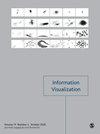附带图形感知:标记和显示时间如何影响准确性
IF 1.8
4区 计算机科学
Q3 COMPUTER SCIENCE, SOFTWARE ENGINEERING
引用次数: 0
摘要
附带的可视化意味着一眼就能感知到,在移动中,在短曝光时间内,但不能在需要时看到。相反,它们出现在人们正在进行的主要任务的视野中。它们与可浏览的可视化不同,因为信息不是按需接收的;它们与环境可视化不同,因为信息不是连续嵌入到环境中。然而,目前的图形感知指南并没有考虑到信息在短暂曝光时间内的特定时刻呈现而不是用户的主要焦点的情况。因此,我们进行了一项有99名参与者的众包用户研究,以了解人们偶然的图形感知的准确性。每个参与者都被测试了三个条件中的一个:点的位置,线的长度和线的角度。我们改变了每个组合的元素数量和显示时间。在研究过程中,参与者被要求执行再现任务,他们必须在每个任务中重现之前显示的刺激。我们的结果表明,当使用位置、长度和角度时,附带的图形感知是准确的。此外,我们认为,附带的可视化应该设计为低曝光时间(300和1000毫秒之间)。本文章由计算机程序翻译,如有差异,请以英文原文为准。
Incidental graphical perception: How marks and display time influence accuracy
Incidental visualizations are meant to be perceived at-a-glance, on-the-go, and during short exposure times, but are not seen on demand. Instead, they appear in people’s fields of view during an ongoing primary task. They differ from glanceable visualizations because the information is not received on demand, and they differ from ambient visualizations because the information is not continuously embedded in the environment. However, current graphical perception guidelines do not consider situations where information is presented at specific moments during brief exposure times without being the user’s primary focus. Therefore, we conducted a crowdsourced user study with 99 participants to understand how accurate people’s incidental graphical perception is. Each participant was tested on one of the three conditions: position of dots, length of lines, and angle of lines. We varied the number of elements for each combination and the display time. During the study, participants were asked to perform reproduction tasks, where they had to recreate a previously shown stimulus in each. Our results indicate that incidental graphical perception can be accurate when using position, length, and angles. Furthermore, we argue that incidental visualizations should be designed for low exposure times (between 300 and 1000 ms).
求助全文
通过发布文献求助,成功后即可免费获取论文全文。
去求助
来源期刊

Information Visualization
COMPUTER SCIENCE, SOFTWARE ENGINEERING-
CiteScore
5.40
自引率
0.00%
发文量
16
审稿时长
>12 weeks
期刊介绍:
Information Visualization is essential reading for researchers and practitioners of information visualization and is of interest to computer scientists and data analysts working on related specialisms. This journal is an international, peer-reviewed journal publishing articles on fundamental research and applications of information visualization. The journal acts as a dedicated forum for the theories, methodologies, techniques and evaluations of information visualization and its applications.
The journal is a core vehicle for developing a generic research agenda for the field by identifying and developing the unique and significant aspects of information visualization. Emphasis is placed on interdisciplinary material and on the close connection between theory and practice.
This journal is a member of the Committee on Publication Ethics (COPE).
 求助内容:
求助内容: 应助结果提醒方式:
应助结果提醒方式:


